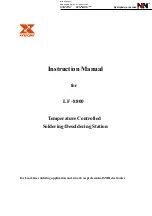
25
PLS 48 D2
GB
|
temperature is too low, the solder does not flow sufficiently and
causes dirty soldering joints (so-called cold soldering joints) . Due
to soldering temperatures which are too high, the solder burns
and the solder does not flow . In addition, the materials to be
processed can be destroyed .
The following temperature settings are for the most common applications .
Differences are possible depending on the solder / manufacturer . The
different levels have no locking function, which ensures the same consistent
setting at the pre-selected level . Slight deviations are possible .
Minimum setting = Room temperature
Level 1: Approx . 100 °C - Warming up level and for solders with
corresponding low melting temperature .
Level 2: Approx . 200 °C Melting point of the most commonly
used soft solder .
Level 3: Approx . 300 °C Normal operation, e .g . when using
lead-free solder .
Level 4: Approx . 400 °C high soldering temperature, e .g . for
removing solder from small solder joints .
Level 5: Approx . 500 °C high soldering temperature, e .g . for
removing solder from larger solder joints .
Summary of Contents for 306960
Page 3: ... ...







































